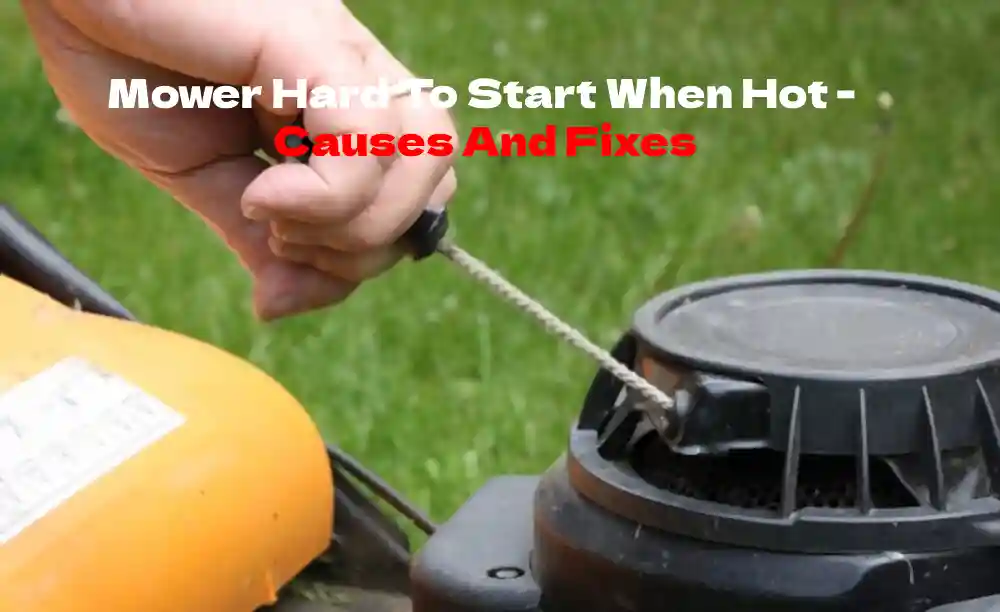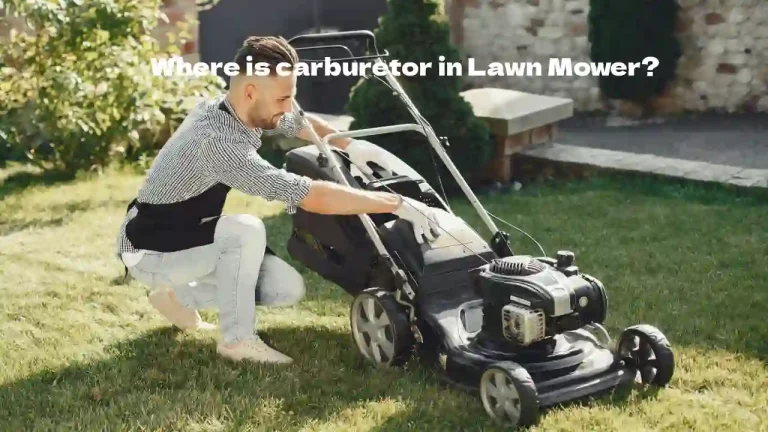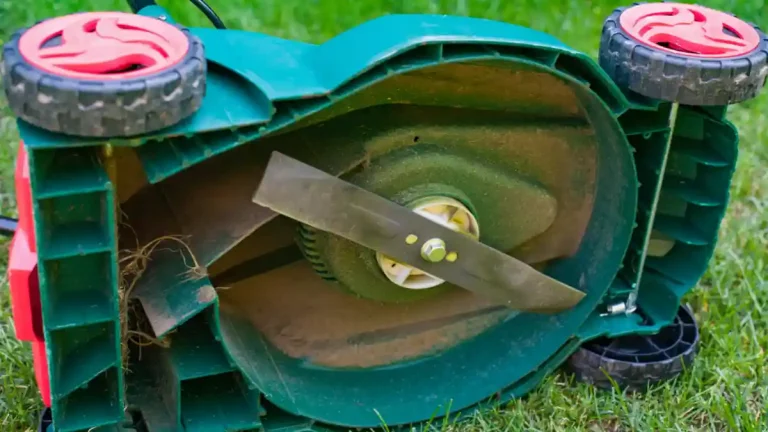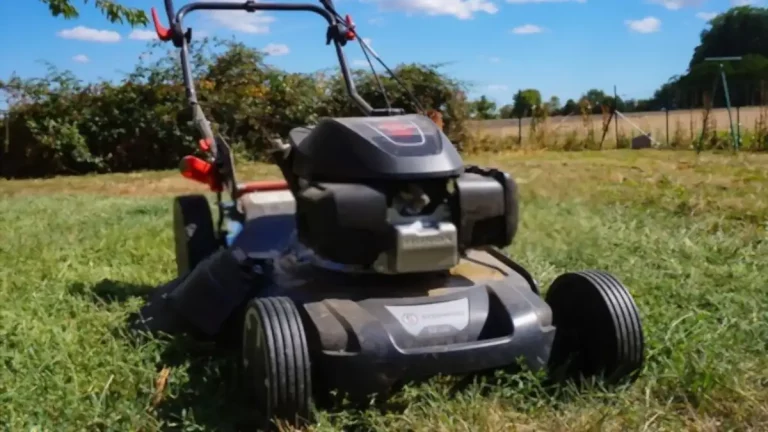Modern motorized garden equipment provides an incredibly efficient way to keep the property tidy. It is remarkable when you think about the technology employed in these miniature engines, which routinely start by pulling a chord or turning an ignition key.
A reluctant hot starting mower is generally caused by
- A faulty spark plug
- The spark plug lead is faulty
- A failing coil
- An overheating engine
- The oil level is low
- A flooded engine
- Auto choke is faulty
- Faulty carburetor
- Low compression
- A faulty valve
It is a common problem, and the best way to trace the cause is to work through the following checklist and eliminate each possibility from the most straightforward fix to the more involved solutions.
9 Possibilities Why A Lawnmower Is Hard To Start When Hot
Ten potential causes make it difficult to start a lawnmower after running, and it is still hot.
The Lawnmower Spark Plug Is Faulty Preventing Hot Starts
The action of the spark plug is one of the three essential steps to make an internal combustion engine start.
To enable an engine to run, it needs fuel, air, and a spark to ignite the fuel/air mixture. The lawnmower coil bursts 20,000 to 30,000 volts through the spark plug wire and into the spark plug. The current reaches the gap at the end of the spark plug, creating a spark that completes the circuit.
The process takes milliseconds and is repeated every engine cycle.
The incorrect spark plug, age, and poor gas quality contribute to a spark plug not operating correctly.
Only a few things can go wrong with a spark plug
- The spark plug gap may be incorrectly set.
- The spark plug is dirty, preventing the current from crossing the gap.
- The incorrect spark plug is being used.
- The spark plug is faulty.
The lawnmower has already been running, so the first two possibilities are unlikely.
The Incorrect Spark Plug Is Being Used On The Lawnmower
Spark plugs are designed to operate in different heat conditions. Check the code on the side of the plug, and you will see the first number after the letters, which is the heat rating of the spark plug.
A colder heat range (lower number) is used under high-temperature conditions.
Check in the lawnmower’s manual to confirm the correct code unit is being used. If not, replace the spark plug with the correct one.
Check If The Spark Plug Is Working
Unscrew the spark plug.
Check the overall condition and the color of the electrodes.
| Condition | Colour | Possible Causes | Solution |
| Normal Plug | Brown or grey deposits on side electrode, | Working Correctly | Clean the plug, check the gap and reinstall it |
| Carbon-fouled plug | Black, dry, fluffy soot on insulator tip and electrodes. | The fuel/air mixture is too rich; the air filter is blocked, a dirty air filter, the lawnmower is left to idle too long. | Switch to “hotter” plug. (The higher the plug number, the hotter the plug.) |
| Oil-fouled plug | Wet, black, oily deposits on insulator tip and electrodes. | The piston rings or valves may be worn or not seated correctly. | Clean the spark plug and check the electrode gap. If the condition repeats, you will need to investigate further. |
Attach a spark plug tester and follow the instructions to check the plug.
If you don’t have a spark plug tester, you can test it in the following manner.
- Attach the removed plug to the spark plug lead.
- Place the spark plug loosely on the cylinder head so that the lower metal body of the spark plug is touching a metallic part of the engine cylinder head.
- Make sure the electrodes do not touch the head.
- Pull the starter cord and watch for a spark in the gap.
There is an issue with the lawnmower’s ignition system if there is no spark.
Obtain a replacement plug, install it, and see if the engine starts.
(Top Tip: When you buy a plug, always buy a spare to keep in a safe place).
The Lawnmowers Spark Plug Lead Is Faulty
There may be a break in the spark plug
lead if there is no spark.
- Check the condition of the cable.
- Check the spark plug wire continuity by using a multimeter.
If there is evident damage, it will need to be replaced.
The lawnmower Won’t Hot Start Because The Coil Is Failing
The coil provides repeated bursts of very high voltage to the spark plug. It is a hard-working component exposed to extremely high temperatures and vibrations because it is installed directly above the cylinder head alongside the flywheel.
As the flywheel turns, an attached magnet spins past the coil and creates a charge in the coil’s windings. A transistor, built into the ignition coil, opens and closes the circuit with each flywheel pass.
As the piston reaches the optimum position, the coil sends bursts of high voltage current to the spark plug.
If the coil fails, this will result in the lawnmower not starting when it is hot.
At increased temperatures, the resistance to the flow of voltage is increased. It is why failing coils will prevent a hot lawnmower engine from restarting.
To check the coil, complete the following steps.
- Remove the engine cover and fuel tank support. It should expose the coil.
- Remove the spark plug lead of the ignition coil.
- Remove kill switch circuit low current wire attached to the coil.
- Remove the coil from the engine.
- If the coil appears undamaged, proceed with the next step.
- Use a multimeter to test the coil.
- Set the multimeter to the resistance of 20kΩ (Ohms)
- Set the positive lead of the multimeter in the position where the spark plug would usually insert. Place the negative tip onto the metal body of the ignition coil.
Check the resistance value/tolerance table in the user’s manual. If you can’t find this, a google search should produce what you are looking for.
9. For most lawnmower coils, a reading of 2.5-5.0 Ω (Ohms) indicates the ignition coil is in working order. No reading indicates a broken circuit, and a higher value indicates a failing coil.
If the reading indicates a fault, replace the coil and attempt to restart the lawnmower.
Overheating Engine May Prevent The Lawnmower From Starting
If the engine is overheating, it could cause severe damage.
The most common reasons for engine overheating are
- The fuel mixture is incorrect, and too little fuel is being supplied.
- The wrong spark plug is being used.
- The incorrect fuel is being used. Regular gas or e10 ethanol is recommended. E15 and e85 ethanol burn hotter and will damage the engine.
- The engine is filthy.
- The cooling fins are obstructed.
A Low Oil Level May Prevent The Lawnmower From Starting
The purpose of the oil is to lubricate the piston chamber to ensure there is minimal friction.
If there is insufficient oil, the engine will overheat and eventually seize.
Make sure there is sufficient, clean oil in the engine, or the correct gas and oil mix is available for a two-stroke lawnmower.
A Flooded Engine Will Prevent The Lawnmower From Starting
Too much fuel has been delivered if the engine is flooded, and now the spark cannot ignite it.
A flooded engine can be caused by over-priming, stuck choke, stuck valve, gummed carburetor, or by trying to restart an automatic choke engine immediately.
There is nothing to do to correct this condition. Place the lawnmower on a level surface and wait for 15 to 20 minutes to allow the gas to evaporate.
Try starting the mower again without engaging the choke.
Other Reasons Preventing A Lawnmower Engine To Start When Hot
There are four other possible causes for an engine not starting when it is hot.
- The auto choke is faulty.
- Faulty carburetor.
- Low compression.
- A faulty valve.
The fixes for each of these conditions are a little more complex, and if you are unsure of your ability, these should be left to a professional repair shop.
Conclusion
A lawnmower not starting when it is hot is a relatively common condition; however, if you follow the above, you should be able to diagnose the fault.
At all times, remember that lawnmower ignition systems may be live, and they carry very high voltages. When you work on these circuits, ensure they are disconnected and that you wear safety gloves.







![Which Way To Tilt A Lawn Mower? [Don’t Do This]](https://howtl.com/wp-content/uploads/2022/04/which-way-to-tilt-lawn-mower-768x432.webp)